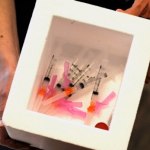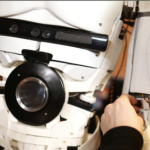07 February 2021
American scientists say they have developed a way to grow wood material in a laboratory. The method could create different wood products indoors in a single process, greatly cutting the cost of production and reducing damage to the world's forests.
Researchers from the Massachusetts Institute of Technology (MIT) demonstrated a proof of concept by growing wood-like structures from cells taken from the leaves of a flowering plant.

This image shows growth progress in an experiment, conducted by a research team from the Massachusetts Institute of Technology (MIT), to grow a wood-like structure in a laboratory from cells taken from a zinnia plant. (MIT/Microsystems Technology Laboratory)
The results were recently reported in a study appearing in the Journal of Cleaner Production. The lead researcher on the project was Luis Fernando Velásquez-García, a scientist in MIT's Microsystems Technology Laboratories.
He told MIT News the process is still in early development. But if it can be perfected, it could simplify and speed up the production of wood products. "The way we get these materials hasn't changed in centuries and is very inefficient," Velásquez-García said.
For example, the current process for making a wooden table can take many years. First, a tree has to grow. Then, it must be cut down, transported, processed, etc. Velásquez-García says lab-grown wood could combine all those steps into one. "If you want a table, then you should just grow a table," he said.
The process is similar in some ways to lab produced meat, which is grown from live animal cells. But in the wood experiment, the MIT team collected live cells from the leaves of a zinnia plant.
The plant cells were then cultured and kept in an environment designed to activate and support growth. "Plant cells are similar to stem cells in the sense that they can become anything if they are induced to," Velásquez-García said.
The experiment was carried out indoors, without soil or sunlight. During the process, the researchers used a mixture of two plant hormones that helped the cells grow a thick, strong wood-like structure. With further development, the researchers say they could use the same process to grow wood in specific shapes, such as a table or chair.
Ashley Beckwith is a doctoral student in mechanical engineering at MIT who led the research. She told MIT News she got the idea for the project while spending time on a farm. She said she wondered whether some of the inefficiencies present in agriculture could be improved through laboratory methods.
"I wanted to find a more efficient way to use land and resources so that we could let more arable areas remain wild," Beckwith said. She says the experiment demonstrated that growing plant tissue in a lab could also have a big effect in agriculture.
Like with wood production, the process could reduce the time and effort related to traditional agriculture methods. It could also remove difficulties linked to weather and seasonality in farming, Beckwith said.
Such a lab-based farming method "promises to improve yields while reducing plant waste and competition for arable land," the research study states.
David Stern is a plant biologist and president of the Boyce Thompson Institute. He was not involved in the study. He told MIT News one big question is whether the technology can be effectively scaled and remain economically competitive.
Stern added that scaling up the method would require major financial and intellectual investments. And he said new issues would arise when bringing parts of forestry and agriculture into the lab. "Agriculture uses the sun's energy through photosynthesis, and...natural rainfall. It does not require buildings, heat, or artificial light," Stern said.
Velásquez-García said his team will be working to improve the method, especially to learn how to better control the final materials that are produced. And, the researchers also want to carry out new experiments to see whether the same results can be reached with other kinds of plants.
I'm Bryan Lynn.
Bryan Lynn wrote this story, based on reports by MIT News and the Journal of Cleaner Production. Susan Shand was the editor.
We want to hear from you. Write to us in the Comments section, and visit 51VOA.COM.
_
Words in This Story
concept – n. an idea of what something is or how it works
inefficient – adj. not capable of producing the desired results without wasting time and energy
culture – v. the beliefs, customs, arts of a particular group of people
induce – v. to cause something to happen next
hormone – n. a natural substance that is produced in the human body and determines how the body grows and develops
arable – adj. suitable for farming
yield – v. to produce something, such as crops
scale – v. a range of levels from low to high
photosynthesis – n. the plant process of deriving nutrients from the sun
artificial – adj. not real, not alive














